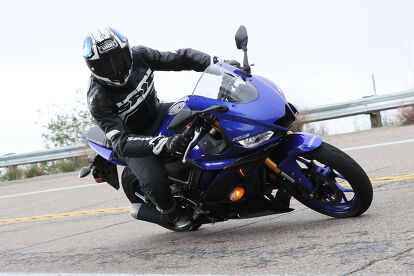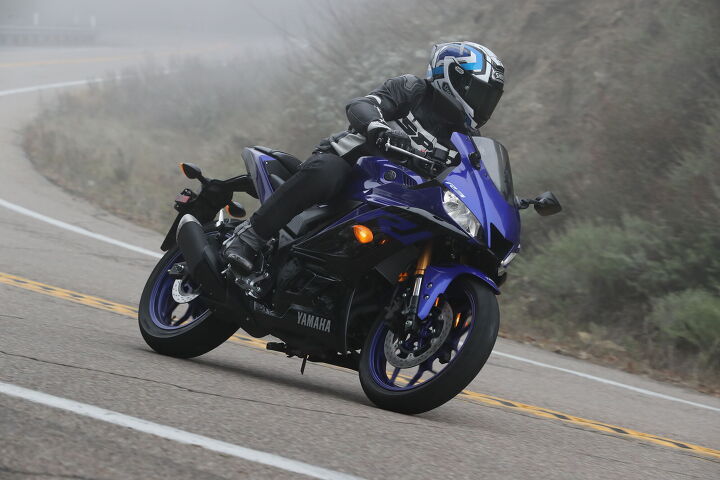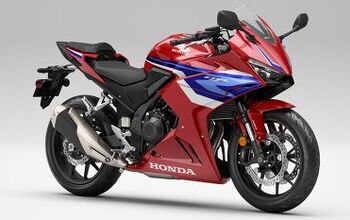2019 Yamaha YZF-R3 Review - First Ride

The Yamaha R3 gets a facelift and new springs to its step
The 2019 Yamaha R3 feels incredibly nimble as I flick it back and forth effortlessly between corners along a mountain road. As we snake our way up into the dense fog surrounding Palomar mountain in San Diego County, dodging gravel and mud that was spread across the roadway from the week’s downpour, I’m thankful for the precise handling the R3 offered. It easily changes direction, almost too easily I think to myself as I close into a tight right-hander just before the apex.
2019 Yamaha R3
| Engine | 16.5/20 |
| Suspension/Handling | 13.0/15 |
| Transmission/Clutch | 8.0/10 |
| Brakes | 7.0/10 |
| Instruments/Controls | 3.5/5 |
| Ergonomics/Comfort | 7.5/10 |
| Appearance/Quality | 9.0/10 |
| Desirability | 8.5/10 |
| Value | 9.0/10 |
| Overall Score | 82/100 |
The small displacement sportbike category is an important one for most manufacturers playing in the segment. Not only are they the conduit by which OEs hope to bring new riders into the fold, but also bikes like the R3 can be halo products in other markets around the world. Not to mention, these bikes are wonderful tools for track enthusiasts to hone their skills on at a lesser cost and risk than larger, more powerful motorcycles.
The R3 is particularly important to Yamaha when considering it has been vying with the MT-07 as the best-selling street motorcycle for some time now. In less than four years, more than 20,000 R3s have been sold making it the current leader in sales for Yamaha U.S. For 2019, the R3 has undergone a complete styling revision to bring it more in line with the looks of its older siblings, the R6 and R1. Looks aren’t the only things to have changed though. Let’s dig a little deeper, past the fairings, to see how Yamaha has developed one of its most important models
Improving on a familiar platform
While the 2019 Yamaha R3 may look all new, Yamaha has left much of the machine unchanged, choosing to focus on improving just a few key areas that deliver added value to the end user. The 321cc Parallel Twin engine remains untouched, still using a 180-degree crankshaft, four-valve DOHC, 68mm bore with a 44.1mm stroke, and forged pistons yielding an 11.2:1 compression ratio. The 1.2-liter airbox, 32mm Mikuni throttle body, and transmission are also the same as previous years.
2015 Yamaha YZF-R3 First Ride Review + Video
Like the R3’s power plant, the steel trellis chassis, ten-spoke aluminum wheels, low seat height and nearly 50/50 weight balance has also remained unchanged. What has changed, and in a fairly big way, is the suspension. The 2019 R3 uses a sporty looking gold USD 37mm KYB fork with 20% stiffer fork springs compared to 2018. Compression and rebound have also been increased for a sportier feel. Keeping those tubes in order is a new forged steel lower triple clamp and new aluminum top triple clamp that is reminiscent of the piece found on the R1M.
The KYB shock has also undergone a spring rate change. Yamaha claims the new shock spring is 11% stiffer with preload increased by 10mm. Rebound has been increased in the shock while compression has been slightly decreased. The only suspension adjustability is preload on the shock.
The suspension changes on both ends make the bike much more fun on canyon roads. The stiffer fork keeps the bike planted under hard braking into corners, while the stiffer spring in the rear helps to keep the bike balanced without any discernible pitching. The revised valving also helps keep the R3 sporty but comfortable, eating up road irregularities with ease. In the past, bikes in this category have been plagued with cheap suspension that feels just that, cheap. Thankfully with the 2019 R3, Yamaha has engineered what I would say is some of the best stock suspension in the category.
Getting ergonomically correct
All of the changes to the plastics surrounding the new R3 aren’t solely cosmetic. Yamaha has lowered the R3’s tank by 20mm and widened it by 31.4mm. This is going to be most beneficial for those looking to take the R3 to the track; allowing riders to get lower on the bike and grip the tank better with their knee/leg. Fuel capacity remains unchanged at 3.7-gallons.
The clip-on-style handlebar has also been revised, sitting under the top triple and lowering the bars by 22mm compared to the previous generation. The new front fairing is also said to provide 7% reduced aerodynamic drag which should mean less helmet buffeting at speed. During my time on the freeway, the riding position combined with the windscreen provided ample wind protection to prevent fatigue during longer freeway blasts. My only complaint with the ergos overall is the seat-to-peg distance seems rather short causing a sharp bend at the knees which left me stretching my legs after a while in the saddle.
The M1 of R3s
Something that’s often underrated in the world of professional motorcyclists like myself, (ha!) is styling. We poke fun at manufacturers when they simply add some BNGs (bold new graphics) for the new model year, but the truth is, it can make all the difference to prospective buyers. What Yamaha has done with the R3 is far from just adding some new decals. This 2019 version had undergone a complete facelift bringing the style in line with that of the R6 and R1 and even the R1M.
At a glance, it’s hard to tell the R-line apart from each other. That’s great for new riders that want to be proud of their motorcycle. The R3, in my opinion, is miles ahead in the styling department of any other bike in the small displacement category and, really, plenty of other larger more expensive motorcycles too. The styling cues like the large central air intake, LED headlight and taillight, aluminum triple clamp design, and large LCD display look similar to Rossi’s M1 MotoGP bike. This is a ride to be proud of at your local bike night.
The 2019 Yamaha R3 starts at $4,999 for non-ABS models which are available in Matte Black and Team Yamaha Blue. ABS-equipped R3s can be had in Vivid White and Matte Black for $5,299. Surprised you can’t get a Team Yamaha Blue with ABS? So were we. One thing you may have noticed about pricing is Yamaha kept the price the same from the previous model year. 2019 Yamaha R3s are in dealerships now. I’ve got a Matte Black model sitting in our MO garage that I’ll be hoping to get out to a racetrack asap. Until then, stay classy, interwebs.
2019 Yamaha R3
+ Highs
- R-world styling makes the 3 look like a 6
- Stiffer suspension keeps the R3 planted during sporty rides
- Ergonomic changes enhance sporting character without compromising street manners
– Sighs
- Tight bend at the knees will leave long-legged riders cramped
- ABS isn’t available in the sexiest color (Team Yamaha Blue)
- Not the 400 many were hoping for
In Gear

Helmet: Shoei X-14 $859.99
- Jacket: Spidi Carbo Rider $649.90
- Air Bag System: Alpinestars Oscar Charlie $1,150
- Pants: REV’IT! Lombard 2 $239.99
- Gloves: Spidi Carbo 4 $229.90
Boots: Dainese Torque D1 Out Gore-Tex $429.95
2019 Yamaha YZF-R3 Specifications | |
|---|---|
| MSRP | $4,999; $5,299 with ABS |
| Engine Type | 321cc liquid-cooled, DOHC inline twin-cylinder; 4 valve per cylinder |
| Bore and Stroke | 68.0 x 44.1mm |
| Fuel System | EFI |
| Compression Ratio | 11.2:1 |
| Transmission | 6-speed; multiplate clutch |
| Final Drive | Chain |
| Front Suspension | Inverted telescopic fork; 5.1-in travel |
| Rear Suspension | Monocross single shock, adjustable preload; 4.9-in travel |
| Front Brake | 298mm hydraulic disc; ABS model available |
| Rear Brake | 220mm hydraulic disc; ABS model available |
| Front Tire | 110/70-17 Dunlop Sportmax GPR-300 |
| Rear Tire | 140/70-17 Dunlop Sportmax GPR-300 |
| Rake/Trail | 25 degrees / 3.7 inches |
| Wheelbase | 54.3 inches |
| Seat Height | 30.7 inches |
| Curb Weight | 368 pounds, 375 pounds with ABS (claimed) |
| Fuel Capacity | 3.7 gal |
| Fuel Economy | 56 mpg (claimed) |
| Available Colors | ABS: Matte Black, Vivid White Non-ABS: Matte Black, Team Yamaha Blue |

Ryan’s time in the motorcycle industry has revolved around sales and marketing prior to landing a gig at Motorcycle.com. An avid motorcyclist, interested in all shapes, sizes, and colors of motorized two-wheeled vehicles, Ryan brings a young, passionate enthusiasm to the digital pages of MO.
More by Ryan Adams








































































































Comments
Join the conversation
In my mind, the strong points for the R3 over the Ninja are it's sharper styling and better suspension settings. The Ninja has a bit more power. I want a 400cc "R4" but in this price constrained segment it seems one can't have it all. These bikes are not about power though.
If in this market, I would grab an R3 for it's better stock suspension, get rid of the orange pumpkin turn signals from the 1980s, and proceed to the nearest smallish racetrack, throttle pinned. The solution for a little less power on bikes like this is easy - ride harder, hold the throttle open longer :)
Not mentioned in the article, but worth mentioning, the R3 has very tall 5th and 6th gears. It achieves it's top speed in 4th gear. 5th and 6th are both overdrives, meant for less hectic freeway cruising.
An RVF400 will spank this and any other low-displacement bike out today. #justsayin